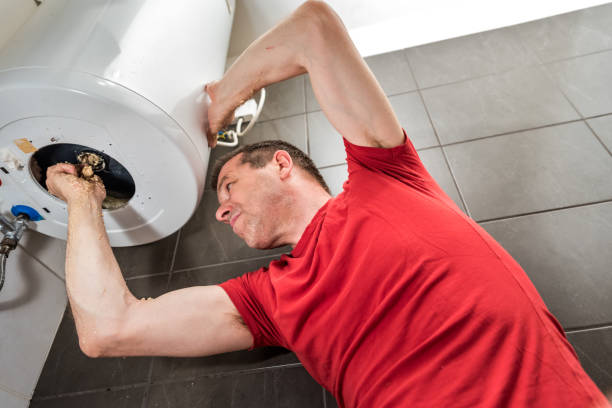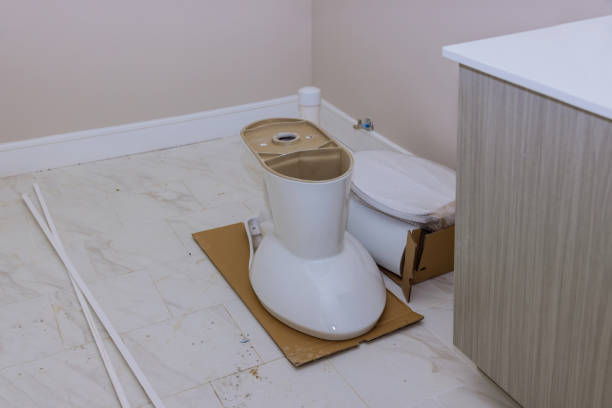Changing a toilet might seem like a simple task, but when it comes to plumbing, it’s often best to leave the job to professionals, and this work might also include installing freestanding baths, showers, and basins. Hiring a plumber ensures that the task is completed efficiently and without any potential issues down the line. However, the cost of hiring a plumber to change a toilet can vary depending on several factors. In this article, we will explore the factors affecting the price, provide an average cost breakdown, offer cost-saving tips, discuss the pros and cons of hiring a professional plumber versus a DIY approach, explain the plumbing process, and provide guidance on finding a reliable and affordable plumber.
Factors Affecting the Cost of Changing a Toilet
Before diving into the average costs, it’s essential to understand the factors that can influence the price of changing a toilet. These factors include:
Location: Plumbers’ rates can vary depending on the region or city you’re in. Areas with a higher cost of living often have higher service charges.
Type of Toilet: The type of toilet you choose can impact the cost. Basic models tend to be more affordable, while high-end or specialty toilets can be pricier.
Toilet Style and Features: Different toilet styles, such as one-piece or two-piece toilets, can affect the price. Additionally, extra features like bidet functionality or smart toilet capabilities can add to the cost.
Removal and Disposal: If your existing toilet needs to be removed and disposed of, the plumber may charge an additional fee for these services.
Plumbing System Complexity: The complexity of your plumbing system can affect the cost. If your plumbing requires additional modifications or repairs, it may add to the overall expenses.
Average Cost of Changing a Toilet
On average, the cost of changing a toilet ranges from $200 to $800. This estimate includes labor charges, materials, and any additional fees. However, keep in mind that these figures can vary significantly based on the factors mentioned earlier.
Cost Breakdown
To understand the cost breakdown, let’s take a closer look at the various components involved:
Labor: Labor costs typically make up a significant portion of the overall expenses. Plumbers charge an hourly rate, which can vary based on their experience, expertise, and location. On average, expect to pay around $50 to $150 per hour for labor.
Toilet Cost: The price of the toilet itself will vary depending on the brand, model, and features. Basic toilets can range from $100 to $300, while more advanced or luxury models can cost several hundred dollars or even more.
Additional Materials: Besides the toilet, you may need additional materials such as wax rings, bolts, and water supply lines. These items are generally inexpensive, ranging from $10 to $50 in total.
Additional Fees: Additional charges might apply for services like removing the old toilet, disposing of it, or any repairs or modifications required for the plumbing system. These fees can range from $50 to $200 or more.
Cost-saving Tips
If you’re looking to minimize the cost of changing a toilet, consider the following tips:
Shop around for quotes: Obtain quotes from multiple plumbers to compare prices and find the best deal.
Choose a basic model: Opt for a simple and cost-effective toilet model without too many added features.
Consider reusing fixtures: If the existing fixtures are in good condition, you can save money by reusing them instead of purchasing new ones.
Handle removal and disposal: If you’re comfortable doing so, you can remove the old toilet and dispose of it yourself to save on additional fees.
Perform minor prep work: Clear the area around the toilet and ensure easy access for the plumber, reducing the time required for the job.
Hiring a Professional Plumber vs. DIY
While some individuals may attempt a DIY approach to changing a toilet to save money, hiring a professional plumber offers several advantages. Here’s a comparison between the two options:
Hiring a Professional Plumber:
Expertise: Plumbers have the necessary skills and experience to handle the job correctly and efficiently.
Time-saving: Professionals can complete the task in less time than a DIY approach, saving you the hassle and potential mistakes.
Guarantees and warranties: Reputable plumbers often provide guarantees and warranties on their work, ensuring peace of mind.
Avoiding potential issues: Plumbers can identify and address any underlying plumbing problems, preventing future complications.
DIY Approach:
Cost savings: If you have experience and confidence in your abilities, a DIY approach can save you money on labor costs.
Personal satisfaction: Completing the task on your own can provide a sense of accomplishment and self-reliance.
However, keep in mind that DIY approaches can be time-consuming, may lead to mistakes or complications, and might not be suitable for complex plumbing systems. In such cases, hiring a professional is often the safer and more efficient option.
Understanding the Plumbing Process
Changing a toilet typically involves the following steps:
Shut off the water supply: Locate the shut-off valve near the toilet and turn it off to stop the water flow.
Drain the tank and bowl: Flush the toilet to remove as much water as possible. Then, use a sponge or towel to soak up any remaining water.
To remove the old toilet, Disconnect the water supply line, unscrew the nuts securing the toilet to the floor, and lift the toilet off the flange.
Install the new toilet: Position the new wax ring on the flange, lower the toilet onto it, and secure it in place with nuts. Reconnect the water supply line.
Test for leaks: Turn on the water supply and flush the toilet several times to check for any leaks. Tighten connections if necessary.
Dispose of the old toilet: If the plumber is responsible for disposal, they will ensure proper removal and disposal of the old toilet.
Factors to Consider Before Hiring a Plumber
Before hiring a plumber to change your toilet, consider the following factors:
Credentials and Licensing: Ensure that the plumber is licensed, insured, and has the necessary qualifications to perform the job.
Experience and Reputation: Check the plumber’s experience level and reputation by reading reviews or asking for references.
Cost Estimate: Obtain detailed cost estimates from multiple plumbers, including a breakdown of labor, materials, and any additional fees.
Availability and Timeline: Discuss the plumber’s availability and the estimated timeline for completing the job.
Communication and Customer Service: Assess the plumber’s communication skills and responsiveness to ensure a smooth and satisfactory experience.
Finding a Reliable and Affordable Plumber
To find a reliable and affordable plumber for changing your toilet, consider the following steps:
Seek Recommendations: Ask friends, family, or neighbors for recommendations based on their past experiences with plumbers.
Online Research: Look for local plumbers online and read customer reviews to gauge their reputation and reliability.
Request Quotes: Contact multiple plumbers and request detailed quotes that include labor, materials, and any additional fees.
Check Credentials: Verify the plumbers’ credentials, licenses, insurance, and any certifications they may have.
Interview and Discuss: Schedule consultations with potential plumbers to discuss your needs, ask questions, and assess their communication and professionalism.
By following these steps, you can find a trustworthy and reasonably priced plumber to change your toilet efficiently.
1. How long does it take to change a toilet?
The time required to change a toilet can vary depending on factors such as the complexity of the plumbing system and any additional repairs needed. On average, it takes a professional plumber around 1 to 2 hours to complete the task.
2. Can I use the existing water supply line for the new toilet?
In some cases, you can reuse the existing water supply line if it’s in good condition. However, it’s recommended to consult with a plumber to assess the line’s condition and determine if replacement is necessary.
3. Do plumbers charge a fee for disposing of the old toilet?
Some plumbers include the cost of disposing of the old toilet in their service fee, while others may charge an additional fee. Make sure to clarify this with the plumber before hiring them.
4. Can I change a toilet myself if I have no plumbing experience?
While it’s technically possible to change a toilet without plumbing experience, it’s generally recommended to hire a professional plumber. Attempting the task without proper knowledge and skills can lead to mistakes, leaks, or damage to the plumbing system.
5. What should I do if I notice a leak after the toilet has been changed?
If you notice a leak after the toilet has been changed, contact the plumber who performed the job immediately. They will assess the situation and address the issue promptly to ensure a proper and watertight installation.
Conclusion
Changing a toilet is a task best left to professional plumbers, considering the potential complexities and importance of a proper installation. The cost of hiring a plumber to change a toilet can vary based on factors such as location, type of toilet, and additional services required. By understanding the cost breakdown, considering cost-saving tips, and assessing the pros and cons of hiring a professional versus attempting a DIY approach, you can make an informed decision. Remember to take the time to find a reliable and affordable plumber, ensuring a smooth and satisfactory experience. So, why wait? Get your toilet changed by a professional plumber and enjoy a hassle-free and efficient installation. If you’re interested in buying a new tap online, then Bathroom Hut stocks are a large range. Shop toilets online now.


